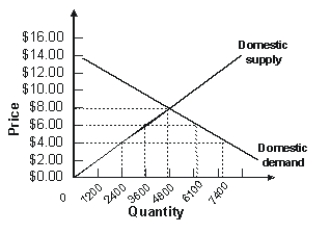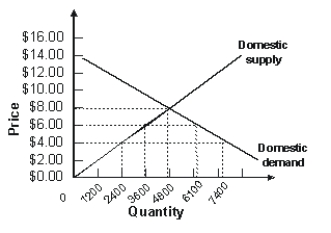A) protects American fisheries from overfishing.
B) uses regulations and taxes to protect American consumers.
C) protects domestic producers from foreign producers.
D) protect is American consumers from foreign producers.
Correct Answer

verified
Correct Answer
verified
True/False
In strategic trade bargaining it is sometimes reasonable to be unreasonable.
Correct Answer

verified
Correct Answer
verified
Multiple Choice
Refer to the graph shown for a small country that is a price taker internationally.  Assume the foreign supply of this product is perfectly elastic at a price of $4 per unit.If government imposes a tariff in the amount of $2 per unit, it will collect revenue in the amount of:
Assume the foreign supply of this product is perfectly elastic at a price of $4 per unit.If government imposes a tariff in the amount of $2 per unit, it will collect revenue in the amount of:
A) $0.
B) $2,400.
C) $5,000.
D) $10,000.
Correct Answer

verified
Correct Answer
verified
Multiple Choice
Economists generally agree that:
A) trade restrictions will increase the welfare of a large country even if other countries retaliate.
B) trade between two nations generally benefits one at the expense of the other.
C) infant industry protection, although justified in theory, often becomes permanent because infant industries fail to grow up.
D) trade embargoes are not an effective way of achieving international political objectives.
Correct Answer

verified
Correct Answer
verified
True/False
Tariffs are taxes that governments place on internationally traded goods.
Correct Answer

verified
Correct Answer
verified
Multiple Choice
Transshipments, which are used commonly in international trade, tend to:
A) undermine the effectiveness of an embargo.
B) strengthen the national security argument for trade restrictions.
C) increase the effectiveness of trade restrictions.
D) reduce the volume of world trade.
Correct Answer

verified
Correct Answer
verified
Multiple Choice
Strategic bargaining:
A) always reduces the number of trade restrictions.
B) always increases the number of trade restrictions.
C) may increase the number of trade restrictions if it is successful.
D) may reduce the number of trade restrictions if it is successful.
Correct Answer

verified
Correct Answer
verified
Multiple Choice
The United States does not allow U.S.citizens to trade with Iraq.This is an example of:
A) a quota.
B) a tariff.
C) an embargo.
D) a regulatory trade restriction.
Correct Answer

verified
Correct Answer
verified
Multiple Choice
Refer to the graph shown for a small country that is a price taker internationally.  Assume the foreign supply of this product is perfectly elastic at a price of $4 per unit.To have the same effect on imports as a $2 per-unit tariff, the government would need to set an import quota of:
Assume the foreign supply of this product is perfectly elastic at a price of $4 per unit.To have the same effect on imports as a $2 per-unit tariff, the government would need to set an import quota of:
A) 1,200 units.
B) 1,300 units.
C) 2,500 units.
D) 5,000 units.
Correct Answer

verified
Correct Answer
verified
True/False
A country imposing trade restrictions can benefit only if other countries also impose trade restrictions.
Correct Answer

verified
Correct Answer
verified
Multiple Choice
Countries restrict international trade for all of the following reasons except:
A) international trade probably will lead to the displacement of workers.
B) the benefits of trade usually are limited to small groups, whereas the costs are widely scattered across the population.
C) it is sometimes difficult to decide where a country's comparative advantage lies when "learning by doing" effects are important.
D) economies of scale can mean that a country is able to develop a comparative advantage by protecting infant industries.
Correct Answer

verified
B
Correct Answer
verified
Multiple Choice
If the United States were to impose 100 percent tariffs on imports of Chinese shrimp, what would most economists conclude?
A) This decision can be justified by using the infant-industry argument.
B) This decision can be justified by using the national defense argument.
C) This policy is a way to keep foreign producers from being exploited by Americans.
D) This decision is not justified in terms of economic well-being but may make sense for political reasons.
Correct Answer

verified
Correct Answer
verified
Multiple Choice
The outsourcing of service jobs such as those in call centers has become a political issue.Do economists see any benefit to outsourcing?
A) No; it simply shifts jobs overseas.
B) No; it only benefits foreign economies.
C) Yes; it tends to reduce prices to American companies and consumers.
D) Yes; it tends to raise the value of the dollar.
Correct Answer

verified
Correct Answer
verified
Multiple Choice
According to most economists, outsourcing service jobs:
A) helps both countries in the long run.
B) hurts both countries because the United States loses jobs and the employees of the call center are exploited with low wages.
C) helps the United States but hurts the country with the low-cost labor.
D) helps the country getting the jobs but hurts the United States
Correct Answer

verified
Correct Answer
verified
Multiple Choice
Analysts have suggested that the cost of bras is related to trade restrictions on textile imports.What does the price of bras have to do with tariffs and quotas?
A) Trade restrictions protect consumers by keeping the price of bras low.
B) Trade restrictions in the form of tariffs keep prices of bras high, but replacing them with quotas will result in lower prices.
C) Trade restrictions keep the prices of bras high, and ending them will result in lower prices.
D) Trade restrictions do not influence the price of bras; the price is determined by domestic technology and the overall inflation rate.
Correct Answer

verified
Correct Answer
verified
Multiple Choice
World trade declined in the 1930s.Which of the following is the best explanation of that decline?
A) World income shrank, and trade restrictions increased.
B) World income shrank, but there were few changes in trade restrictions.
C) Trade restrictions increased, but there was little change in world income.
D) The incomes of most nations increased, allowing them to become more self-sufficient.
Correct Answer

verified
A
Correct Answer
verified
Multiple Choice
Threats to put tariffs on a nation in an attempt to get that nation to reduce its restrictions on trade are called:
A) strategic trade policies.
B) trade adjustment assistance programs.
C) learning by doing.
D) inertia and cachet.
Correct Answer

verified
Correct Answer
verified
True/False
Quotas on imported automobiles cost jobs in the U.S.automobile industry but lower auto prices for domestic consumers.
Correct Answer

verified
Correct Answer
verified
Multiple Choice
Which of the following is not an argument in favor of protecting domestic industries from foreign competition?
A) National security.
B) Reducing structural unemployment.
C) Protection against subsidized foreign producers.
D) Making domestic firms more efficient.
Correct Answer

verified
Correct Answer
verified
Multiple Choice
The WTO authorized several countries to impose about $150 million in trade sanctions against the United States in retaliation for a U.S.import law that the WTO ruled to be illegal.The organization that issued this ruling against the United States is known as the:
A) Wage Tariff Objective.
B) World Trade Organization.
C) Wealth Technology Order.
D) Welfare Tax Order.
Correct Answer

verified
B
Correct Answer
verified
Showing 1 - 20 of 79
Related Exams